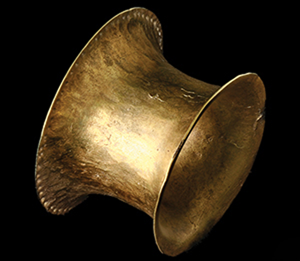Crossref Citations
This article has been cited by the following publications. This list is generated based on data provided by
Crossref.
Monge Soares, António M.
Melo, Linda
Valério, Pedro
Silva, Ana Maria
Pais Martins, Pedro
Monge Soares, Rui M. G.
Cerqueira Alves, Luis
Araújo, Maria Fátima
Baptista, Lídia
Casimiro, Maria Helena
Mota Ferreira, Luis
and
Silva, Rui J. C.
2021.
Símbolos de estatus o una visión de los primeros momentos del Bronce Medio del suroeste: las estructuras funerarias de Horta do Pinheiro 5 (Torrão do Alentejo, sur de Portugal).
Trabajos de Prehistoria,
Vol. 78,
Issue. 2,
p.
292.
Villalba-Mouco, Vanessa
Oliart, Camila
Rihuete-Herrada, Cristina
Childebayeva, Ainash
Rohrlach, Adam B.
Fregeiro, María Inés
Celdrán Beltrán, Eva
Velasco-Felipe, Carlos
Aron, Franziska
Himmel, Marie
Freund, Caecilia
Alt, Kurt W.
Salazar-García, Domingo C.
García Atiénzar, Gabriel
de Miguel Ibáñez, Ma. Paz
Hernández Pérez, Mauro S.
Barciela, Virginia
Romero, Alejandro
Ponce, Juana
Martínez, Andrés
Lomba, Joaquín
Soler, Jorge
Martínez, Ana Pujante
Avilés Fernández, Azucena
Haber-Uriarte, María
Roca de Togores Muñoz, Consuelo
Olalde, Iñigo
Lalueza-Fox, Carles
Reich, David
Krause, Johannes
García Sanjuán, Leonardo
Lull, Vicente
Micó, Rafael
Risch, Roberto
and
Haak, Wolfgang
2021.
Genomic transformation and social organization during the Copper Age–Bronze Age transition in southern Iberia.
Science Advances,
Vol. 7,
Issue. 47,
Rivera Jiménez, Timoteo
García Sanjuán, Leonardo
Díaz-Guardamino, Marta
Donaire Romero, Teodosio
Morales González, Juan Antonio
Lozano Rodríguez, José Antonio
Rogerio Candelera, Miguel Ángel
Bermejo Meléndez, Javier
and
Aguilera Collado, Elena
2021.
The Cañaveral de León stela (Huelva, Spain). A monumental sculpture in a landscape of settlements and pathways.
Journal of Archaeological Science: Reports,
Vol. 40,
Issue. ,
p.
103251.
Díaz-del-Río, Pedro
Uriarte, Antonio
Becerra, Paula
Pérez-Villa, Alberto
Vicent, Juan M.
and
Díaz-Zorita, Marta
2022.
Paleomobility in Iberia: 12 years of strontium isotope research.
Journal of Archaeological Science: Reports,
Vol. 46,
Issue. ,
p.
103653.
Buikstra, Jane E.
DeWitte, Sharon N.
Agarwal, Sabrina C.
Baker, Brenda J.
Bartelink, Eric J.
Berger, Elizabeth
Blevins, Kelly E.
Bolhofner, Katelyn
Boutin, Alexis T.
Brickley, Megan B.
Buzon, Michele R.
de la Cova, Carlina
Goldstein, Lynne
Gowland, Rebecca
Grauer, Anne L.
Gregoricka, Lesley A.
Halcrow, Siân E.
Hall, Sarah A.
Hillson, Simon
Kakaliouras, Ann M.
Klaus, Haagen D.
Knudson, Kelly J.
Knüsel, Christopher J.
Larsen, Clark Spencer
Martin, Debra L.
Milner, George R.
Novak, Mario
Nystrom, Kenneth C.
Pacheco‐Forés, Sofía I.
Prowse, Tracy L.
Robbins Schug, Gwen
Roberts, Charlotte A.
Rothwell, Jessica E.
Santos, Ana Luisa
Stojanowski, Christopher
Stone, Anne C.
Stull, Kyra E.
Temple, Daniel H.
Torres, Christina M.
Toyne, J. Marla
Tung, Tiffiny A.
Ullinger, Jaime
Wiltschke‐Schrotta, Karin
and
Zakrzewski, Sonia R.
2022.
Twenty‐first century bioarchaeology: Taking stock and moving forward.
American Journal of Biological Anthropology,
Vol. 178,
Issue. S74,
p.
54.
Peres, Marcello
and
Risch, Roberto
2022.
Espacios y fuerzas sociales en el centro y el este de la península ibérica entre 2200 y 1550 ANE: una aproximación macroespacial.
Trabajos de Prehistoria,
Vol. 79,
Issue. 1,
p.
47.
Beck, Jess
and
Quinn, Colin P.
2022.
Balancing the scales: archaeological approaches to social inequality.
World Archaeology,
Vol. 54,
Issue. 4,
p.
572.
Moreno-Vera, Juan
and
Martínez-Leguízamo, Jeisson
2022.
Welcome Refugees! The Use of Cultural Heritage to Teach Democratic Values.
Sustainability,
Vol. 14,
Issue. 20,
p.
13466.
Han, Tao
Zhang, Wenxin
Xie, Yaoting
Zhou, Xuyang
Zhu, Hong
Zhang, Quanchao
and
Wang, Qian
2022.
Sex-Based Differences in Age-Related Changes of the Vertebral Column from a Bronze Age Urban Population in Ancient China.
Anthropological Review,
Vol. 85,
Issue. 1,
p.
107.
2022.
Isis Current Bibliography of the History of Science and Its Cultural Influences 2022.
Isis,
Vol. 113,
Issue. S1,
p.
1.
Ruiz Zapatero, Gonzalo
2022.
Díaz-del-Río, P., Lillios, K. y Sastre, I. Eds. (2020): The Matter of Prehistory: Papers in Honor of Antonio Gilman Guillén. Madrid, CSIC (Bibliotheca Praehistorica Hispana, 36), 365 pp. Tapa dura tela. ISBN 978-84-00-10721-5.
Complutum,
Vol. 33,
Issue. 2,
p.
565.
Villalba-Mouco, Vanessa
Oliart, Camila
Rihuete-Herrada, Cristina
Rohrlach, Adam B.
Fregeiro, María Inés
Childebayeva, Ainash
Ringbauer, Harald
Olalde, Iñigo
Celdrán Beltrán, Eva
Puello-Mora, Catherine
Valério, Miguel
Krause, Johannes
Lull, Vicente
Micó, Rafael
Risch, Roberto
and
Haak, Wolfgang
2022.
Kinship practices in the early state El Argar society from Bronze Age Iberia.
Scientific Reports,
Vol. 12,
Issue. 1,
Haughton, Mark
2023.
Gender in Earlier Bronze Age Ireland and Scotland.
European Journal of Archaeology,
Vol. 26,
Issue. 1,
p.
19.
Diogo, Rui
Adesomo, Adeyemi
Farmer, Kimberly S.
Kim, Rachel J.
and
Jackson, Fatimah
2023.
Not just in the past: Racist and sexist biases still permeate biology, anthropology, medicine, and education.
Evolutionary Anthropology: Issues, News, and Reviews,
Vol. 32,
Issue. 2,
p.
67.
Cintas-Peña, Marta
Luciañez-Triviño, Miriam
Montero Artús, Raquel
Bileck, Andrea
Bortel, Patricia
Kanz, Fabian
Rebay-Salisbury, Katharina
and
García Sanjuán, Leonardo
2023.
Amelogenin peptide analyses reveal female leadership in Copper Age Iberia (c. 2900–2650 BC).
Scientific Reports,
Vol. 13,
Issue. 1,
Ibarz Navarro, Sergio
Murillo-Barroso, Mercedes
and
Legarra Herrero, Borja
2023.
Aproximación a la distribución del espacio funerario en El Argar (Antas, Almería).
Trabajos de Prehistoria,
Vol. 80,
Issue. 1,
p.
e05.
Basso Rial, Ricardo
Jover Maestre, Francisco Javier
and
L´ópez Padilla, Juan Antonio
2023.
Estratigrafía, radiocarbono y producción textil: seriación cronotipológica de las pesas de telar de la Edad del Bronce en el cuadrante suroriental de la península ibérica.
Zephyrvs,
Vol. 90,
Issue. ,
p.
91.
Streiffert Eikeland, Katarina
2023.
Female Presence in Maritime Settings–Trade and Warfare.
Journal of Maritime Archaeology,
Vol. 18,
Issue. 2,
p.
129.
Garrido Pena, Rafael
2023.
Más allá de “El Argar”: periferia y margen de una singularidad prehistórica. Comentario a Peres y Risch.
Trabajos de Prehistoria,
Vol. 80,
Issue. 2,
p.
e25.
Barciela González, Virginia
García Atiénzar, Gabriel
Martín de la Sierra Pareja, Paula
and
Hernández Pérez, Mauro S.
2023.
Los adornos personales en la orfebrería de Cabezo Redondo (Villena, Alicante) y su contexto histórico.
Complutum,
Vol. 34,
Issue. Especial,
p.
109.
